Low-Order Autoignition Modeling for Hydrogen Transverse Jets
IF 2.4
4区 工程技术
Q2 ENGINEERING, AEROSPACE
引用次数: 0
Abstract
This paper presents a method for evaluating the risk of autoignition for the canonical problem of an enclosed hydrogen jet in crossflow (JICF), which is highly relevant to the design of mixing ducts. The proposed method is based on the separation of the underlying mixing pattern from the evolution of the chemical reactions, whereas the effect of mixing is maintained on the latter with the purpose of creating a reliable yet computationally efficient design tool for hydrogen gas turbines. Two variants of the incompletely stirred reactor network (ISRN) approach are proposed that provide the evolution of preignition radicals and autoignition kernel location, leveraging a nonreacting computational fluid dynamics solution or an analytical mixing pattern. The ISRN governing equations include all the salient features of hydrogen transport and lead to a conservative estimate of autoignition risk. Application to a few model problems with varied operating conditions suggests that radical buildup in the JICF can lead to autoignition in the vicinity of a most reactive mixture fraction, which is consistent with other laminar or turbulent hydrogen flows. However, the radical formation and autoignition kernel location strongly depend on the prediction of the underlying mixing field and the amount of differential diffusion within the JICF, which here primarily favors lower values of the composite mixture fraction and the transport of hydrogen and radicals away from the jet trajectory.氢横向射流的低阶自燃模型
本文提出了一种评估交叉流中封闭氢射流典型问题自燃风险的方法,该问题与混合管道的设计高度相关。所提出的方法基于将潜在的混合模式与化学反应的演变相分离,而混合的效果则保持在化学反应上,目的是为氢气涡轮机创建一个可靠但计算高效的设计工具。提出了不完全搅拌反应器网络(ISRN)方法的两种变体,利用非反应计算流体动力学解决方案或分析混合模式,提供了预燃自由基和自燃核位置的演变。ISRN控制方程包括氢传输的所有显著特征,并导致对自燃风险的保守估计。应用于不同操作条件下的几个模型问题表明,JICF中的自由基积聚可能导致在反应性最强的混合物部分附近自燃,这与其他层流或湍流氢流一致。然而,自由基的形成和自燃核的位置在很大程度上取决于底层混合场的预测和JICF内的差分扩散量,这在这里主要有利于复合混合物分数的较低值以及氢和自由基从射流轨迹的传输。
本文章由计算机程序翻译,如有差异,请以英文原文为准。
求助全文
约1分钟内获得全文
求助全文
来源期刊

Journal of Propulsion and Power
工程技术-工程:宇航
CiteScore
4.20
自引率
21.10%
发文量
97
审稿时长
6.5 months
期刊介绍:
This Journal is devoted to the advancement of the science and technology of aerospace propulsion and power through the dissemination of original archival papers contributing to advancements in airbreathing, electric, and advanced propulsion; solid and liquid rockets; fuels and propellants; power generation and conversion for aerospace vehicles; and the application of aerospace science and technology to terrestrial energy devices and systems. It is intended to provide readers of the Journal, with primary interests in propulsion and power, access to papers spanning the range from research through development to applications. Papers in these disciplines and the sciences of combustion, fluid mechanics, and solid mechanics as directly related to propulsion and power are solicited.
 求助内容:
求助内容: 应助结果提醒方式:
应助结果提醒方式:


